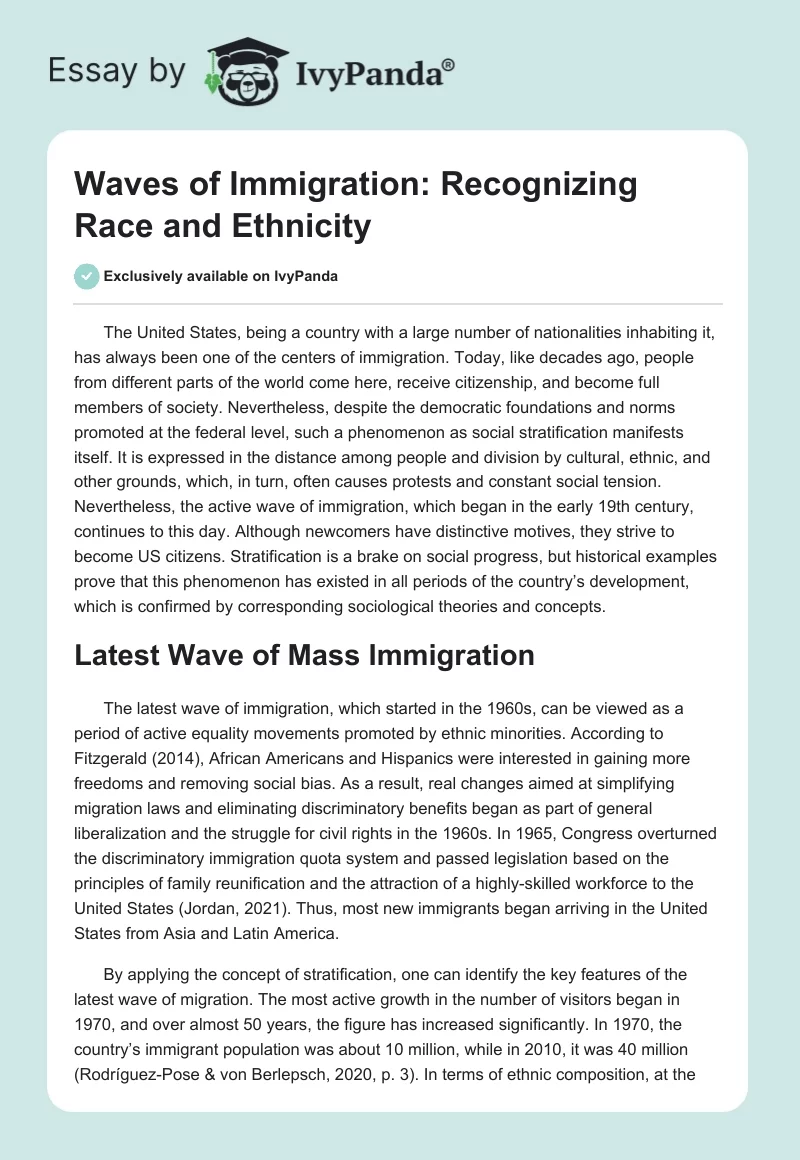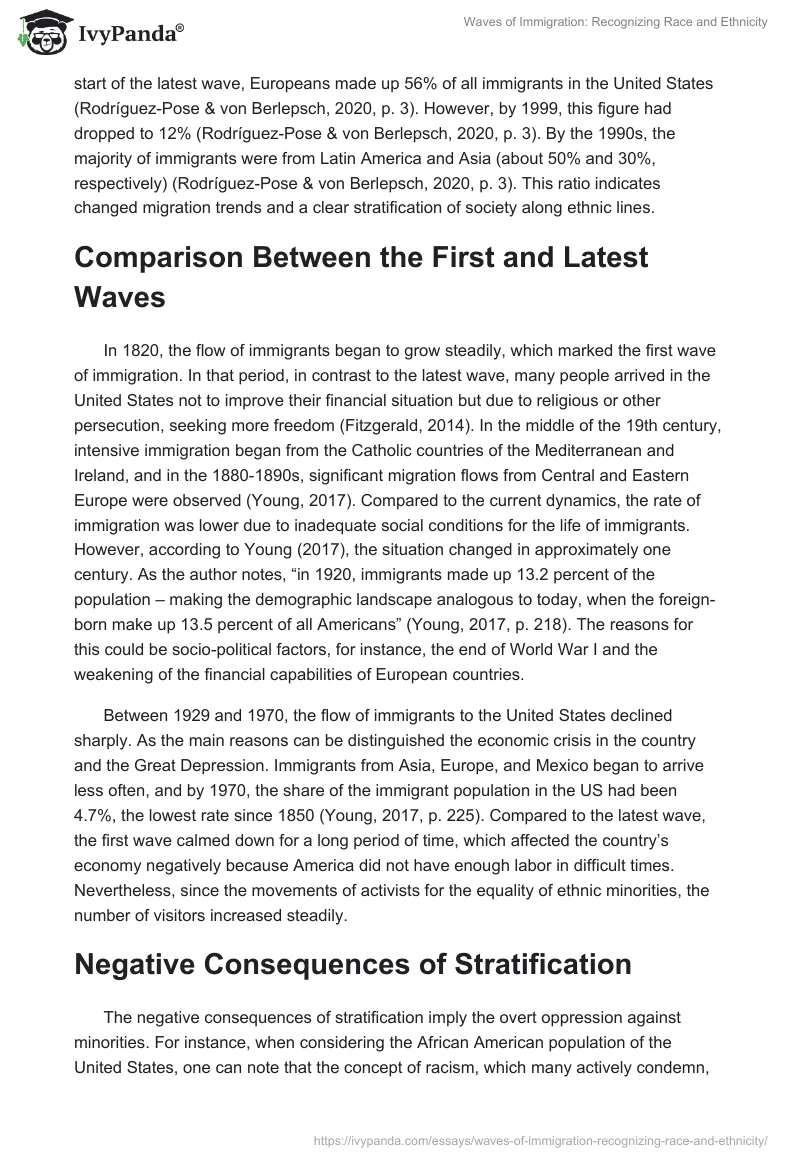The United States, being a country with a large number of nationalities inhabiting it, has always been one of the centers of immigration. Today, like decades ago, people from different parts of the world come here, receive citizenship, and become full members of society. Nevertheless, despite the democratic foundations and norms promoted at the federal level, such a phenomenon as social stratification manifests itself. It is expressed in the distance among people and division by cultural, ethnic, and other grounds, which, in turn, often causes protests and constant social tension. Nevertheless, the active wave of immigration, which began in the early 19th century, continues to this day. Although newcomers have distinctive motives, they strive to become US citizens. Stratification is a brake on social progress, but historical examples prove that this phenomenon has existed in all periods of the country’s development, which is confirmed by corresponding sociological theories and concepts.
Latest Wave of Mass Immigration
The latest wave of immigration, which started in the 1960s, can be viewed as a period of active equality movements promoted by ethnic minorities. According to Fitzgerald (2014), African Americans and Hispanics were interested in gaining more freedoms and removing social bias. As a result, real changes aimed at simplifying migration laws and eliminating discriminatory benefits began as part of general liberalization and the struggle for civil rights in the 1960s. In 1965, Congress overturned the discriminatory immigration quota system and passed legislation based on the principles of family reunification and the attraction of a highly-skilled workforce to the United States (Jordan, 2021). Thus, most new immigrants began arriving in the United States from Asia and Latin America.
By applying the concept of stratification, one can identify the key features of the latest wave of migration. The most active growth in the number of visitors began in 1970, and over almost 50 years, the figure has increased significantly. In 1970, the country’s immigrant population was about 10 million, while in 2010, it was 40 million (Rodríguez-Pose & von Berlepsch, 2020, p. 3). In terms of ethnic composition, at the start of the latest wave, Europeans made up 56% of all immigrants in the United States (Rodríguez-Pose & von Berlepsch, 2020, p. 3). However, by 1999, this figure had dropped to 12% (Rodríguez-Pose & von Berlepsch, 2020, p. 3). By the 1990s, the majority of immigrants were from Latin America and Asia (about 50% and 30%, respectively) (Rodríguez-Pose & von Berlepsch, 2020, p. 3). This ratio indicates changed migration trends and a clear stratification of society along ethnic lines.
Comparison Between the First and Latest Waves
In 1820, the flow of immigrants began to grow steadily, which marked the first wave of immigration. In that period, in contrast to the latest wave, many people arrived in the United States not to improve their financial situation but due to religious or other persecution, seeking more freedom (Fitzgerald, 2014). In the middle of the 19th century, intensive immigration began from the Catholic countries of the Mediterranean and Ireland, and in the 1880-1890s, significant migration flows from Central and Eastern Europe were observed (Young, 2017). Compared to the current dynamics, the rate of immigration was lower due to inadequate social conditions for the life of immigrants. However, according to Young (2017), the situation changed in approximately one century. As the author notes, “in 1920, immigrants made up 13.2 percent of the population – making the demographic landscape analogous to today, when the foreign-born make up 13.5 percent of all Americans” (Young, 2017, p. 218). The reasons for this could be socio-political factors, for instance, the end of World War I and the weakening of the financial capabilities of European countries.
Between 1929 and 1970, the flow of immigrants to the United States declined sharply. As the main reasons can be distinguished the economic crisis in the country and the Great Depression. Immigrants from Asia, Europe, and Mexico began to arrive less often, and by 1970, the share of the immigrant population in the US had been 4.7%, the lowest rate since 1850 (Young, 2017, p. 225). Compared to the latest wave, the first wave calmed down for a long period of time, which affected the country’s economy negatively because America did not have enough labor in difficult times. Nevertheless, since the movements of activists for the equality of ethnic minorities, the number of visitors increased steadily.
Negative Consequences of Stratification
The negative consequences of stratification imply the overt oppression against minorities. For instance, when considering the African American population of the United States, one can note that the concept of racism, which many actively condemn, has not ceased to exist even today. Skin color bias is unacceptable because this is a manifestation of archaic attitudes that demean human dignity and cannot be regarded as acceptable assessment criteria (Khanacademymedicine, 2014). The protests initiated in the recent past by the BLM movement are an example of how dangerous racism can be if it directly affects human life. Discrimination is also worth mentioning as a concept that includes prejudice based on different criteria, such as social class (Khanacademymedicine, 2014). Due to discrimination against African Americans, these citizens are often viewed as representatives of a low social class, which is unacceptable in an environment where human rights are important determinants of a civilized state. Therefore, stratification carries many negative aspects that are crucial to overcome for the normal development of society and maintaining respect for different ethnic and cultural groups.
Social stratification is an indirect manifestation of the conflict theory. The overlap of distinctive points of view within society or a particular community is inevitable, which prompts people to accept certain sides and, therefore, to conflict (Khanacademymedicine, 2013). For instance, proponents of equal rights promote the ideas of equality and fraternity, while conservatives see no other way but to differentiate people by class. Simon (2016) highlights the relationship between the conflict theory and stratification and notes that they complement each other, causing competition between social groups. The critical race theory may be applied to the aforementioned group of African Americans and analyzed as an ideology that stimulates the dominance of one race over another, particularly whites over blacks (Fitzgerald, 2014). Taking into account the long-term struggle of the black population in the United States for their rights, this theory manifests itself in real life in the context of the aforementioned concepts of discrimination and racism. Stratification must be eradicated by leveling the playing field for African Americans and tightening criminal penalties for racially motivated bias.
With regard to additional measures to minimize the consequences of stratification in society, more attention should be paid to public coverage of any cases of racial discrimination. Engaging formal and informal media resources is a reasonable initiative to promote social equity and educate people about the negative outcomes of prejudice. Fitzgerald (2014) also mentions education as a social area in which relevant interventions can help eliminate racial bias. Equal educational opportunities for school students will help eradicate racism among children and adolescents, thereby creating positive incentives for the younger generation. The situation is similar in the healthcare field; inequalities in access to medical services exacerbate social tensions and accentuate stratification. Providing equal access to qualified healthcare services to whites and blacks is a valuable step in addressing the effects of class division, thereby addressing acute inequalities. All of these measures are essential initiatives to promote both nationally and globally and create a favorable environment with no clear majority and minority division.
Conclusion
Social stratification is a phenomenon that negatively affects the development of society; nevertheless, as practice shows, the ideology of class division has existed in all periods of the country’s development. The concepts of discrimination and racism emphasize inequality, and one of the groups experiencing ethnic bias is the African American population. The conflict and critical race theories relate to social stratification and emphasize the persistence of differences in many people’s views, including from a primitive perspective. The analysis of immigrant waves shows that in both the 19th century and the first half of the 20th century, newcomers were under pressure from the dominant strata of society. Specific legislative initiatives improved the situation and created more conditions for the free life of non-Americans. However, acute problems of discrimination and bias persist, which require intervention through urgent actions in social areas, including healthcare, education, and the media.
References
Fitzgerald, K. J. (2014). Recognizing race and ethnicity: Power, privilege, and inequality. Westview Press.
Jordan, C. (2021). Tracing war bride legislation and the racial construction of Asian immigrants.Asian American Research Journal, 1(1), 1-17. Web.
Khanacademymedicine. (2013). Social theories overview (part 1) | Society and culture | MCAT | Khan Academy [Video]. YouTube. Web.
Khanacademymedicine. (2014). Prejudice and discrimination based on race, ethnicity, power, social class, and prestige [Video]. YouTube. Web.
Rodríguez-Pose, A., & von Berlepsch, V. (2020). Migration-prone and migration-averse places. Path dependence in long-term migration to the US.Applied Geography, 116, 1-14. Web.
Simon, R. M. (2016). The conflict paradigm in sociology and the study of social inequality: Paradox and possibility. Theory in Action, 9(1), 1-31. Web.
Young, J. G. (2017). Making America 1920 again? Nativism and US immigration, past and present. Journal on Migration and Human Security, 5(1), 217-235. Web.


